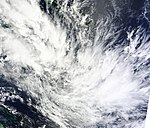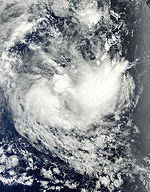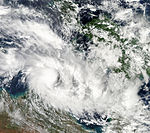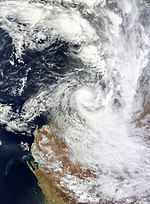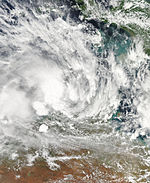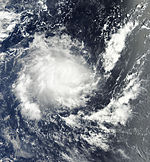2011–12 Australian region cyclone season
| 2011–12 Australian region cyclone season |

Season summary map
|
| Seasonal boundaries |
| First system formed |
3 December 2011 |
| Last system dissipated |
30 June 2012 |
| Strongest storm |
|
| Name |
Lua |
| • Maximum winds |
165 km/h (105 mph)
(10-minute sustained) |
| • Lowest pressure |
930 hPa (mbar) |
| Seasonal statistics |
| Tropical lows |
21 |
| Tropical cyclones |
7 |
| Severe tropical cyclones |
2 |
| Total fatalities |
16 |
| Total damage |
> $230 million (2012 USD) |
| Related articles |
|
|
Australian region tropical cyclone seasons
2009–10, 2010–11, 2011–12, 2012–13, 2013–14, |
| Category 3 severe tropical cyclone (Australian scale) |
| Category 2 tropical cyclone (SSHWS) |
|
|
| Duration |
3 December – 11 December |
| Peak intensity |
140 km/h (85 mph) (10-min) 972 hPa (mbar) |
| Tropical low (Australian scale) |
|
|
| Duration |
18 December – 23 December |
| Peak intensity |
55 km/h (35 mph) (10-min) 994 hPa (mbar) |
| Tropical low (Australian scale) |
|
|
| Duration |
21 December – 28 December (Exited basin)
|
| Peak intensity |
Winds not specified |
| Category 2 tropical cyclone (Australian scale) |
| Tropical storm (SSHWS) |
|
|
| Duration |
21 December – 2 January |
| Peak intensity |
100 km/h (65 mph) (10-min) 978 hPa (mbar) |
| Category 3 severe tropical cyclone (Australian scale) |
| Category 1 tropical cyclone (SSHWS) |
|
|
| Duration |
9 January – 13 January |
| Peak intensity |
150 km/h (90 mph) (10-min) 960 hPa (mbar) |
| Tropical low (Australian scale) |
|
|
| Duration |
22 January – 27 January |
| Peak intensity |
Winds not specified 995 hPa (mbar) |
| Category 2 tropical cyclone (Australian scale) |
| Category 1 tropical cyclone (SSHWS) |
|
|
| Duration |
24 January – 3 February |
| Peak intensity |
110 km/h (70 mph) (10-min) 974 hPa (mbar) |
| Category 2 tropical cyclone (Australian scale) |
| Tropical storm (SSHWS) |
|
|
| Duration |
1 February – 6 February (out of basin)
|
| Peak intensity |
100 km/h (65 mph) (10-min) 979 hPa (mbar) |
| Tropical low (Australian scale) |
| Tropical storm (SSHWS) |
|
|
| Duration |
5 February – 14 February (Exited basin)
|
| Peak intensity |
65 km/h (40 mph) (1-min) 1000 hPa (mbar) |
The 2011–12 Australian region cyclone season was a below average tropical cyclone season, with 7 cyclones forming rather than the usuall 11. It began on 1 November 2011, and ended on 14 May 2012. The regional tropical cyclone operational plan defines a "tropical cyclone year" separately from a "tropical cyclone season"; the "tropical cyclone year" began on 1 July 2011 and ended on 30 June 2012.
The scope of the Australian region is limited to all areas south of the equator, east of 90°E and west of 160°E. This area includes Australia, Papua New Guinea, western parts of the Solomon Islands, East Timor and southern parts of Indonesia.
Tropical cyclones in this area are monitored by five Tropical Cyclone Warning Centres (TCWCs): the Australian Bureau of Meteorology in Perth, Darwin, and Brisbane; TCWC Jakarta in Indonesia; and TCWC Port Moresby in Papua New Guinea. The Joint Typhoon Warning Center issues unofficial warnings for the region, designating tropical depressions with the "S" suffix when they form west of 135°E, and the "P" suffix when they form east of 135°E.
During each tropical cyclone year, Australia's Bureau of Meteorology National Climate Centre (BoM), the Guy Carpenter Asia-Pacific Climate Impact Centre, New Zealand's National Institute of Water and Atmospheric Research (NIWA) and partners issue seasonal forecasts for the Australian region and its various subregions. Since a tropical cyclone can move through a region, the actual number of tropical cyclones in a region include any that form in or move into a region from another.
...
Wikipedia




